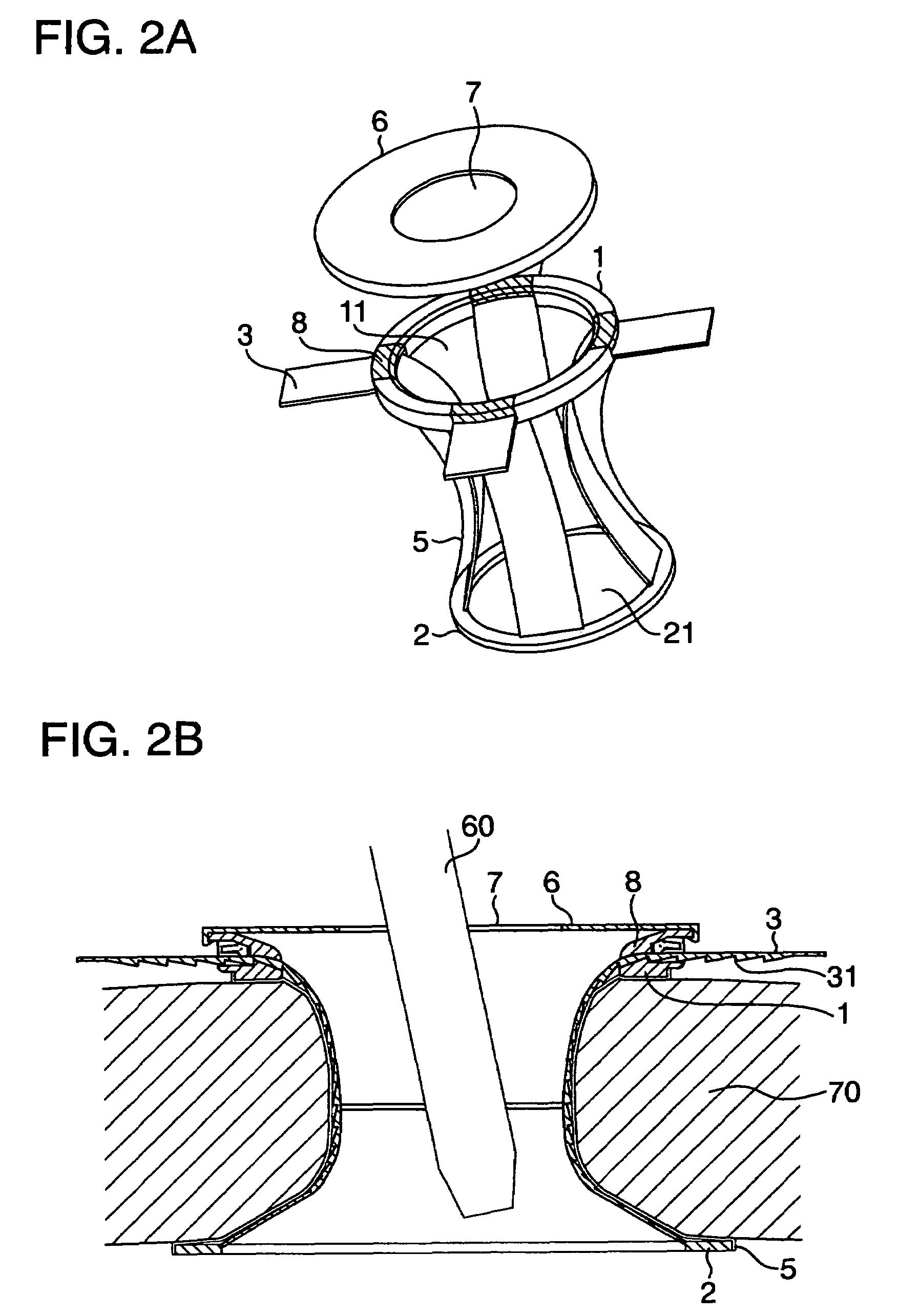On the part of the operator, there are disadvantages that since the operator performs the operation, using treatment instruments, such as a plurality of
forceps, while viewing an image projected on a screen by the
endoscope, the manipulation is difficult, and much time is required, so that the operator undergoes a considerable stress.
Particularly, it tends to take a long time to perform an operation on the
stomach and the
large intestine, and the operator undergoes a great stress.
However, there have been
encountered problems “that when the incision is opened by the threads, the threads are brought into
biting engagement with that portion of the
abdominal wall defining the incision, so that it is sometimes difficult to sufficiently open the incision”, and “that there are provided projections for fixing a fixing member spacing-adjusting sheet, and this sheet is provided around the opened incision, so that it is sometimes difficult to take out the organ and to effect the treatment.”
However, this method has a drawback that it is rather difficult to move the
forceps or the like forward and backward since they are fixed by the valve in a squeezed manner.
And besides, when the arm is inserted, it is sometimes difficult to maintain an airtight condition since the arm varies in thickness particularly in accordance with the forward and backward movement, and in this case it is necessary to adjust the throttling of the valve.
Furthermore, the force of fixing of the device on the
abdominal wall depends only on
rubber elasticity of the cylindrical member, and therefore this device has a problem that it can not flexibly meet the thickness of the abdominal wall, so that the incision can not be sufficiently opened.
In addition, the incision in the abdominal wall is large relative to the treatment instrument such as forceps, and any portion of the abdominal wall does not serve as a fulcrum for the treatment instrument during the manipulation thereof, so that the manipulation of the forceps is complicated.
And besides, the opening of the incision depends only on the stretchability of the sheet, and therefore there has been encountered a problem that the thickness of the abdominal wall may prevent the incision from being sufficiently opened.
That portion, extending outwardly from the bonded portion, can not be separated, and therefore unless the drape is
cut so as to once take out the whole of the device or unless the sleeve portion is
cut, the organ can not be taken out of the body, and can not be treated.
If the device is taken out, there is a fear that a
cancer-affected tissue adheres to the abdominal wall.
However, it is difficult to snappingly fit the rings of the sleeve and abdominal wall-fixing member together over their entire periphery, and if this fitting connection is incomplete at any region, an airtight condition can not be maintained.
Also in this device, when a treatment instrument such as forceps is manipulated through the sleeve, there has been encountered a drawback that the manipulation of the forceps is complicated since an incision in the abdominal wall is large relative to the treatment instrument, and any portion of the abdominal wall does not serve as a fulcrum for the treatment instrument during the manipulation thereof.
However, in the device of U.S. Pat. No. 5,366,478, when the organ is to be taken out of the body for treatment purposes after a pneumoperitoneum condition is canceled, the
balloon must be contracted with the result that an incision is closed, and therefore there has been a drawback that an additional incision-opening instrument must be used.
In both of the above devices, the
balloon is inflated in the circumferential direction, so that the height of the device from the
body surface increases, and therefore it is difficult to sufficiently take the organ out of the body, and besides there has been encountered a problem that forceps or the like can not be easily located at that part to be treated.
However, this device has a drawback that when the organ is to be taken out of the body for treatment purposes after a pneumoperitoneum condition is canceled or when an affected part is to be treated while directly viewing this part through an incision, particularly the slit-like valve becomes obstructive.
Also in this device, when a treatment instrument is manipulated through the sleeve, there has been encountered a drawback that the manipulation of the treatment instrument such as forcepts is complicated since an incision in the abdominal wall is large relative to the treatment instrument, and any portion of the abdominal wall does not serve as a fulcrum for the treatment instrument during the manipulation thereof.
However, this device can not flexibly meet the size of the incision and the thickness of the abdominal wall, and therefore there has been encountered a problem that the incision can not be sufficiently opened.
However, there has been a fear that the incision is damaged since the annular member is threaded into the incision.
And besides, there has been encountered a problem that the annular member becomes bulky since the thread angle, facilitating a threading operation, is provided, and furthermore there has been a drawback that this device can not flexibly meet the thickness of the abdominal wall and the size of the incision.
 Login to View More
Login to View More  Login to View More
Login to View More 


